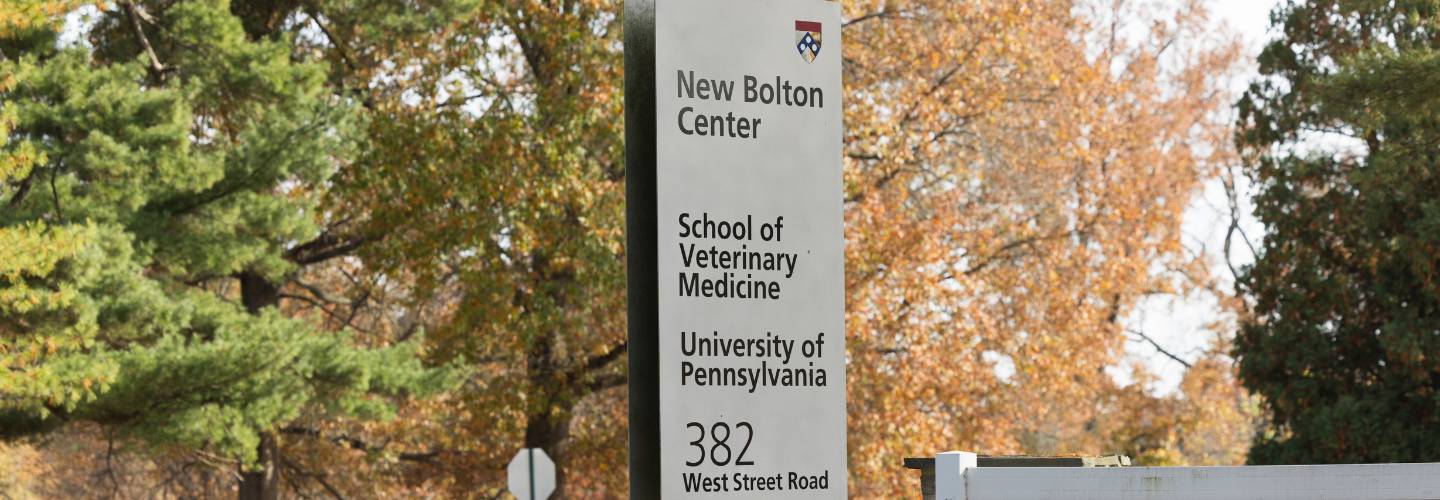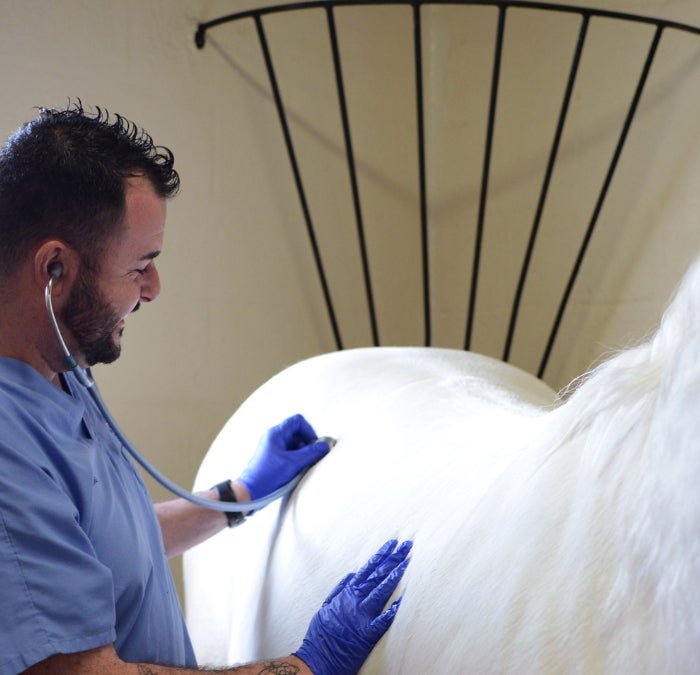
About the New Bolton Center
Located on a campus of 700 acres in Chester County, Pennsylvania, the University of Pennsylvania’s New Bolton Center at the School of Veterinary Medicine provides an internationally renowned standard of care for large animals of all sizes, ranging from pet goats to elite equine athletes and high-producing dairy herds.
Handling more than 6,300 hospital patient visits annually — with its large animal Field Service ambulatory practice treating more than 22,400 patients at local farms in southeastern Pennsylvania and surrounding regions — Penn Vet’s New Bolton Center carries one of the largest caseloads of any large animal veterinary teaching hospital in the United States. Open 24 hours a day, seven days a week, and 365 days a year, Penn Vet’s New Bolton Center offers a comprehensive suite of advanced large animal veterinary services — backed by more than seventy highly trained, board-certified veterinary specialists.
Board certification requires extensive additional training, which strongly influences the veterinarian’s expertise in treating patients. After receiving a veterinary degree (DVM or VMD), a large animal criticalist must complete a residency program in large animal surgery, medicine, or anesthesia. Following completion of a residency, board certification in the specialty is obtained by passing a comprehensive examination given by the specialty college (ACVS, ACVIM, or ACVAA).
After completion of the residency, the prospective specialist will receive a minimum (or equivalent) of two to three additional years of intense training in emergency, surgery, and critical care through completion of an American College of Veterinary Emergency and Critical Care (ACVECC)-approved training program.
Once the veterinarian has completed these years of specialty residency training, the individual must then pass a rigorous board-certification examination given by the ACVECC. Upon successful completion of the training and passing of the examination, the veterinarian is a Diplomate of the ACVECC, is termed a “specialist” in emergency critical care, or a “criticalist”, and is board-certified in veterinary emergency and critical care.
Distinguished
New Bolton Center Facilities
We offer state-of-the-art facilities to provide a wide array of care to fit your animal’s needs.
The James M. Moran, Jr. Critical Care Center
The center is for patients suffering from critical diseases, from neonates to adults. The opening of this facility in 2010 greatly increased the hospital’s capacity and ability to care for critically ill patients.
Features include:
- A single-story structure with two separate wings: one for isolation patients and one for critical patients.
- An isolation wing to provide a bio-secure environment and containment area for animals suffering from infectious diseases. This section of the Critical Care Center allows for the safe treatment of our patients without the risk of spreading disease to other animals.
- Two wings with their own procedure rooms, pharmacy area, laundry rooms, equipment storage, and equipment cleaning rooms.
- Specialized stalls with a hoist and padding for neurological or recumbent cases, multiple large stalls with dividers for mares and foals, and air-conditioned stalls for respiratory cases.
- ECGs, blood pressure monitors, intravenous infusion pumps, hot air blankets, oxygen and other medical gas outlets, ventilators, and specially designed stalls that allow mares to have contact with their foals without disrupting the neonate’s medical care.
- An environmentally controlled air circulation system and pressurized central corridors.
- Technical advances that allow for more efficient and effective care and monitoring of patients.
C. Mahlon Kline Orthopedic and Rehabilitation Center
Named in memory of C. Mahlon Kline, the building was erected in 1975 through the generosity of his family and the C. Mahlon Kline Foundation.
The building is home to an orthopedic surgical suite which includes a unique pool recovery system. Dr. Jacques Jenny, considered the father of large-animal orthopedic surgery, envisioned a system where horses could emerge from anesthesia without injury. To that end, the CMK operating room at New Bolton Center’s Hospital is equipped with a monorail that runs from the operating room to the recovery pool.
Our pool-recovery system allows the disoriented animal to awaken suspended in a specially engineered harness and rubber raft. This recovery technique allows the patient to reach near full consciousness in the warm water, significantly reducing the risk of re-injuring the damaged limb. Once awake, the horse is hoisted from the raft and moved to the recovery stall where he can stand.
- Pre-Clinical Services / Comparative Orthopedic Research Lab (PSC-CORL) is also located in the building.
Equine Performance Evaluation Facility
Care of the equine athlete demands specialized facilities to evaluate performance, diagnose subtle lameness and detect musculoskeletal problems using sophisticated equipment in conjunction with our clinicians’ highly developed observational powers.
The Equine Performance and Evaluation Facility (EPEF) is an enclosed arena, provides a comfortable, indoor setting to conduct lameness examinations, performance diagnostics, and other critical tests in a safe, clement environment conducive to accurate and reliable assessments of a horse’s mobility.
- The EPEF provides superior footing, optimal lighting and a dedicated space protected from the elements. This facility is a real advantage to the entire treatment team: clinicians, clients, students and of course, our patients.
Georgia and Philip Hofmann Research Center for Animal Reproduction
(Located one mile southwest of the main New Bolton Center Hospital)
Our team includes five board-certified specialists in reproduction or behavior, working in collaboration with sports medicine and imaging, medicine, and surgery colleagues at New Bolton Center, to offer a comprehensive approach to case management.
Equine breeding services Include:
- Breeding by natural cover
- Semen collection, evaluation, and chilled transport
- Semen freezing
- Mare cycle management
- Artificial insemination
- Mare and stallion breeding soundness examinations
- Mare and stallion infertility examinations & therapy
- Embryo transfer with recipient herd
- Reproduction-related performance problems
Specialty service in stallion handling and behavior
- Starting and re-schooling stallions for breeding
- Dummy mount training — ground semen collection
- Assisting disabled and aging stallions
- Evaluation and therapy for libido, erection, and ejaculation dysfunction
We also offer short courses for owners, managers, farm staff, veterinary technicians, veterinarians, animal scientists, and students.
Hofmann Center at New Bolton Center
443 Bartram Road
Kennett Square, PA 19348
(610) 925-6364
High Speed Treadmill Facility
More than 3,000 patient evaluations have been carried out on the Jeffords Treadmill for poor performance issues such as lameness, upper and lower respiratory tract changes, cardiac disease, and sub-clinical myopathy (“tying-up”).
The tailor-made treadmill offers the ability to follow up a comprehensive lameness exam for a poorly performing horse with a brief schooling test, during which the patient may have arterial catheters placed in a facial artery and an endoscope passed into the pharynx.
A typical test is run for 1600 meters at a speed designed to increase the horse’s heart rate to 200 beats per minute. The horse is immediately taken off the treadmill, and a postexercise echocardiogram is performed.
An ECG is taken before, during, and after exercise, and a post-exercise bronchoalveolar lavage (endoscopic washing with sterile fluid of the lungs, allowing clinicians to examine cell samples that aid in diagnosis) is performed.
Subsequently, all of the data is taken from each test, and a solution is proposed to the client to improve their horse’s performance.
The Scott Equine Sports Medicine Facility
Dedicated in 2002, the Scott Equine Sports Medicine facility is a state-of-the-art facility that consists of two diagnostic areas — one with two sets of stocks for diagnostic ultrasound and one with a single-stock space dedicated to cardiology, plus three holding stalls and a Cardiology/Ultrasound Office where studies can be examined.
The latest in high-tech ultrasound, echocardiography, EKG, and radiotelemetry equipment is available, and ultrasound is used in various ways to detect possible health issues in horses.
The generous space, great footing and high ceilings make it a welcoming space for patients, owners, clinicians, and students.
New Bolton Center Recovery Pool System
The University of Pennsylvania School of Veterinary Medicine’s New Bolton Center has long been revered as a first-class equine hospital, partly because of its pool recovery system designed to help horses safely come out of anesthesia.
Put into use 40 years ago, the pool was a critical innovation in equine surgical procedures that require the horse to be placed under anesthesia. While several other equine hospitals now have pool recovery systems, they differ fundamentally from the New Bolton Center pool.
In the other systems, the horse is partially submerged in the water and supported directly with a sling system. Because the horse and its newly repaired limb are in the water, considerable care is required to keep the surgical site dry.In the New Bolton Center system, the horse’s body and limbs are within the rubber raft, which keeps the horse’s body dry. As horses are prey animals, their first instinct when recovering from anesthesia is to stand and run, which endangers any repairs made to an injured limb. Horses that scramble after a fracture repair can overload the limb so much that the surgical repair can fail, even in a padded stall with human help during recovery.
Dr. Jacques Jenny, nicknamed the “father of equine orthopedic surgery,” created the pool-raft system in use at New Bolton that allows horses to safely regain consciousness before being asked to bear weight on a repaired limb.
The C. Mahlon Kline Orthopedic and Rehabilitation building houses both the indoor recovery pool and surgical suites at the hospital. The pool is 22 feet wide and 11 feet deep; it holds 30,000 gallons of continuously filtered, brominated water at 96 degrees F. The pool is surrounded by a cantilevered deck that allows access to the horse while preventing the horse’s legs from striking the wall during recovery.
The raft on which the horse is placed is a six-man; U.S. Navy life raft that is modified to accommodate the horse’s limbs. A rail system lifts the horse from the surgical table and into the raft and pool, then out of the pool and into a recovery stall.
Essential to Large Animal Care
Interns, Residents, and Nurses
Interns and Residents
An intern is a veterinarian who is seeking additional training in a more specialized hospital environment for one year. Most interns rotate through multiple services in our hospital, obtaining a broad exposure to veterinary medicine or there specialty interns who focus on a single field.
A resident is a veterinarian who has already completed an internship, and has decided to continue their training in a particular specialty, typically for three-years. At the end of their residency they will look to become board-certified in a specialty service through an exam process.
Penn Vet Nurses
A Penn Vet nurse is someone who embodies the essence of compassion, dedication, and unwavering commitment. Our nurses have many responsibilities that include animal care, laboratory specimen analysis, surgical assistance, anesthesia, radiographic imaging (x-ray), nutritional management, dental prophylaxis, physical therapy, and client education.

